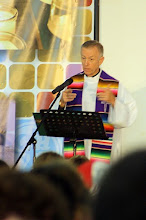
I recently wrote a piece about “Memory and Identity”—that item was general in its thrust. This one is much more specific: Monday is the feast of St Anne, Mother of the Mother of God, and patron of my old parish in Chicago.
From 19 to 26 July every year my old parish, St Joseph & St Anne (now merged with St Agnes, one block away, and given the new name of Our Lady of Fatima) celebrated (and still celebrates) its Novena to St Anne. It involved guest preachers, 3-4 evening outdoor processions with the Blessed Sacrament while praying the Rosary, and Benediction: sometimes in the church, sometimes on the steps outside. I was an altar server for several years for these events (repeated during the same days of August, in Polish).
While our church is on 38th Pl, the property (and our school) was on 39th St, otherwise known as Pershing Rd. It is a significant thoroughfare, as is California Av, the other intersecting street. Both have bus lines. Yet somehow we managed to get the City to place sanitation district saw-horses to block off traffic, enabling us to process south from 38th Pl to Pershing Rd; then west from California to Francisco; north again to 38th Pl, and finally east back to the church. If I remember correctly the police chief of our precinct (their office was across the street from our school) was a member of the parish…
Along the way, most of the houses were ready for the occasion. Front-yard shrines of our Lord, or the Blessed Mother, usually lit up, were everywhere; sometimes people were sitting on their porches and joining in the prayers as we passed by, even if they didn’t join in the procession. These shrines were often illuminated with devotional candles.
The procession was led by a car (a convertible) in which a priest rode, with a bull-horn, leading the Rosary so everyone could hear. The great thing, of course, is that folks could make the responses to the prayers without really worrying about the words, so they could concentrate on not falling while walking. Directly behind the car was the priest carrying the monstrance with the Blessed Sacrament. I think the rule for this (and the outdoor Benediction) was “weather-permitting.” But most of the time, weather did indeed permit.
Our church had a side chapel to the left of the main sanctuary—our national shrine to St Anne. There were the leavings of folks who claimed cures from her intercession: mostly leg braces and crutches. There was also inscribed this quote: “You have loved justice and hated iniquity; therefore, God, your God, has anointed you above your fellows.” It is from Psalm 45:8, though I don’t think I was aware of the source when I was young.
In other words, in the 1950s/1960s in Chicago we could be (and were) Catholic pretty well without having to worry about it: it’s who we were and what we did. We lived in my old neighborhood (a curious mix of 2/3 Polish and 1/3 Mexican) rather like we were in Tevye’s Anatevka: Because of our traditions, every one of us knows who he is, and what God expects him to do.
But times (and locales) have changed. I received a Facebook post today from friends in Oak Ridge, TN: their church has been vandalized in a vulgar way, and police have labeled it an anti-Catholic hate crime. It is all so pathetic. But then, even in Fiddler on the Roof, Anatevka was the victim of intolerance and violence, and a pogrom which ends the musical. Sadly, perhaps the old saying Plus ça change… is true: “The more things change, the more they stay the same.”
I miss the old traditions and the sense of community, and the security they produced. It may be that, like seminary (literally, a seed-bed or hot-house) this was only an experience intended to help us “root” until we are ready to be transplanted into the world of parish priest-life, or of disciple-life. Still, it’s good to remember where we come from.
[Only family will care about this, but the picture above is our church, and the priest to the right, Fr Barr, was the pastor who ministered to my Dad when he was dying, and who surprised me by being at my Mom's wake, some 20 years later. He is a good, good priest.]

Yes, it is certainly true that the sense of community is best enjoyed, I believe, through a Catholic spirit of church. To have a neighborhood so involved with devotions to a particular saint obviously created solidarity among all ages. Today, the sports worlds of baseball, football, and soccer, for example, appear to have replaced God-directed gatherings. The practice times coincide with church times -- the team comraderie becomes the strength of community. God choices are forgotten. I hope they can be revived with present generations.
ReplyDelete